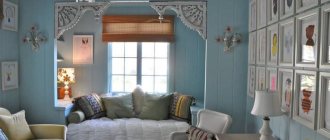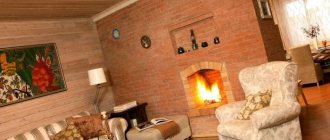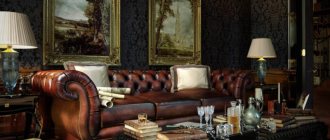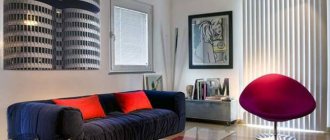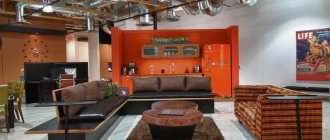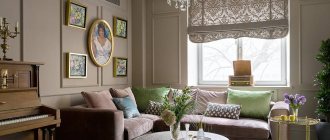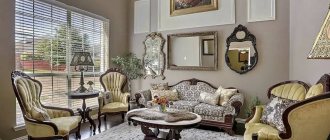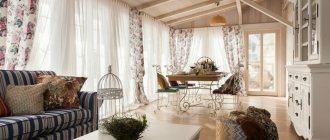The discreet and functional contemporary style is the optimal solution for lovers of comfort and simplicity. The first attempts to implement this trend in interiors took place already in the 60s of the last century, but the formation of the style was completed just a few years ago. This made it possible to saturate it with current trends in modern design.
This direction is not the prerogative of exclusively wealthy homeowners. Its simplicity and competent approach to the use of space allows you to create a comfortable atmosphere without much investment, even in a small area.
The style is optimal for decorating a home, apartment or office. It has no restrictions that put the designer in strict limits. Contemporary art does not fit into the technology of high-tech and the laconicism of minimalism. When creating interiors, common sense and the convenience of future residents are a priority.
- History of the style
- Features, characteristics and distinctive features of style
- Who chooses contemporary style
- What area is contemporary style suitable for?
- Color solutions for style
- Materials and methods of interior decoration Walls
- Floor
- Ceiling
- Hallway/corridor
History of the style
Сontemporary first declared itself in the middle of the twentieth century. It absorbed the features of the Scandinavian style, minimalism and constructivism. At that time, individual and communal apartments had a modest design. The interior was formed from furniture and decorative elements of mass production. Many parts were purchased “on occasion”; getting something exclusive in those days was a great success. In apartments, along with modest and laconic furnishings, antiques from various styles and even eras could be present.
In the post-war years, the decoration of houses was characterized by a certain eclecticism. Therefore, the modernity of the interior was permeated by details of styles that had a long history. Architects and designers of the Bauhaus school had a hand in the development and spread of the style in Europe. They promoted the idea of creating mass production of comfortable and affordable furniture capable of organizing many objects and things. According to their plan, it should have a stylish and beautiful appearance, and a budget price.
By the end of the twentieth century, almost every American, Russian or European family could boast of such furniture. Every apartment had a standard kitchen unit or wall. Consumers highly appreciated the opportunity to acquire inexpensive, yet elegant and functional modern furniture. Many of its elements are still actively used to create interiors.
The relevance of the contemporary style lies in its unique ability to combine modern materials and furniture from chain stores with antique items. According to the designers, in the future this direction will only transform, develop and will not lose its popularity for a long time.
Style basis
The principles of decorating a room in a contemporary style are based on convenience and common sense.
This interior direction is “based on three pillars”: convenience, simplicity, functionality.
The interior should not be oversaturated with numerous details
Despite the fact that the requirements for a room made in this style do not fit into a clear framework, there are still some rules that should be followed.
- Simplicity of form, conciseness and restraint. Furniture, decoration, lighting fixtures, textiles in the interior - everything should be in moderation, all objects of simple shapes. The main principle: “Little means a lot” (the use of a small amount of furniture and objects leaves room for space, air and light).
- A large amount of light in the room, both artificial and natural (simple solutions are used for windows: single-layer curtains, fabric roller blinds, or not decorated). Houses are designed with a large number of windows, with panoramic and attic windows; in apartments, if possible, window openings are expanded.
- Functionality. A large number of storage systems, preferably hidden from view. All interior items carry their own functional load, even decorative elements are usually used that carry some meaning for the owners (for example, souvenirs from iconic travels).
- Zoning of premises. For zoning, light and the color of surfaces are used, podiums are arranged, zoning is allowed with the help of light, weightless structures (for example, shelving).
- Combined bathroom. Combining a bathroom and a restroom allows you to get a larger space, which is indispensable for this direction. A glass shower cabin without a tray is more appropriate here than a bathtub (its installation is acceptable in homes where the area of bathrooms can be impressive).
- Application of technology for integrating furniture and household appliances.
If you look closely, contemporary art shows features of the Scandinavian style, minimalism and constructivism
The style will definitely appeal to people who often change their interiors
See alsoGrunge style in the interior
Features, characteristics and distinctive features of style
Since the style is based on the spontaneous inclusion of furnishings into the interior, when decorating a room there is no need to follow strict rules within a certain historical era. The components that fill the room appear in it only for the reason that the owners liked them. Therefore, there is no need to maintain a color palette in certain shades, purchase designer furniture and order curtains of a certain style. Here it is possible to decorate surfaces with modern materials and fill the room with comfortable factory-made furniture.
Who chooses contemporary style
This direction embodies the features of modernity, it is very easy to implement, which is why it is popular among those who like to frequently update the interior. The core qualities on which the contemporary style is based are simplicity, comfort and functionality. It is suitable for everyone who values practicality, convenience and does not tolerate pretentiousness and excessive pomp.
The beauty of the style is that the interiors created in it are unique. Every time an original solution is created from simple and publicly available things.
The ergonomics and convenience of this style make it indispensable for decorating office premises. The variety and variability of modules and designs make it possible to organize the workspace taking into account the individual needs of each employee. The monotony of the walls will be diluted by paintings and photographs.
Interior
The peculiarity and originality of contemporary art is that this style manifests itself spontaneously in the interior. There is no fancy idea here, no difficult concept to look for or guess. Everything is simple, uncomplicated and at the same time modern and convenient.
Color spectrum
The main background palette of contemporary art is neutral tones: beige, gray, brown, white, cream. This is the basis for various color accents that appear in textiles, accessories, and fluffy rugs. The task of additional elements is to create comfort and a positive mood in a somewhat expressionless and even “cold” (in terms of color) room.
The color of the furniture is dim, muted (dark blue, graphite gray, brown).
Materials
The most modern materials are used. Glass, metal, stone are preferred, artificial materials are appropriate. But the fabrics should be natural, with a pronounced structure (cotton, wool, linen, jute).
Sea pebbles, skins and fur, rattan, raw stone and wood - everything that is close to the origins of nature also fits perfectly into a modern contemporary interior.
Walls, floor, ceiling
The wall decoration is unobtrusive. It can be modest wallpaper or just a painted, light surface. Ceilings are mostly made of plasterboard, and lighting is often built into them. The flooring is laminate, natural wood in light colors or tiles, depending on the purpose of the room.
Windows and doors
Simple doors and modern plastic windows with simple decor will fit perfectly into a contemporary interior.
Furniture
Cabinet (modular, sectional) furniture is one of the characteristic features of contemporary art. Built-in wardrobes, lots of shelves and drawers will come in handy here.
The furniture pieces are made in simple shapes and clear lines. Upholstered furniture is usually light, unpretentious, and low. Armchairs, poufs and chairs, as a rule, are of more saturated colors. These are a kind of bright spots in a slightly faceless interior. Many attributes are made of glass, acrylic and plastic, thereby creating a feeling of spaciousness and lightness in the room.
Decor and accessories
There are no special restrictions in the design of the premises. Cute little things and trinkets, vases, paintings and figurines will enliven the room, making it warmer and more comfortable. But still there should not be too much.
Textiles, accessories, bright details, collections of modern paintings and sculptures, lamps - all this opens up space for a unique mixture of stylizations.
For example, walls covered with wallpaper in classic vertical stripes and several vases in an antique spirit will recreate the main features of classicism.
The picturesque pattern on the wallpaper and curtains, draperies and tassels will be reminiscent of Baroque paintings. Plain walls with colorful landscapes, careless folds of curtains and blankets, cozy corners and trinkets will give the interior a romantic character.
An important element of a contemporary interior is lighting, often hidden. Illuminated niches, walls and other areas participate in the formation of space. An interior in this style tends towards massive forms, so large containers are selected for indoor plants. And small photographs and graphic drawings in dark frames are placed on the walls as a complete composition.
One of the key principles of style is the unification of space.
This is done in order to obtain maximum free space. Open layout and visual zoning are very important for contemporary style. The kitchen is usually combined with the living room, and the bar counter separates these two areas. Also, the border can serve as a ceiling and floor structure or a dining group (table and chairs). The furniture is laconic, with built-in appliances. There should be no overload: everything is clear and functional.
A large wall-length wardrobe with glass doors is appropriate in the bedroom. In the living room there is a modular wall and upholstered furniture in rich colors. The highlight of the children's room are textile handbag shelves for storing children's things and toys.
Contemporary interiors are distinguished by rigor and neatness; they do not repel either lovers of the classics or admirers of the high-tech style.
From the point of view of convenience and ergonomics, this style can be called ideal.
What area is contemporary style suitable for?
Contemporary style is the best option for decorating small-sized modern apartments. All its elements are easily transformed and adjusted to the proposed circumstances. When implementing it, priority is given to the correct organization of living space, through its competent division into functional zones.
A room with simple geometry is the best option for embodying style. This design will look best in a standard room in an ordinary panel high-rise building. Modern furniture of simple and clear shapes with clear outlines and straight lines, high-tech devices, posters, photographs and paintings can easily fit into it. Affordable and functional finishing products will provide an excellent backdrop. It is better to choose single-color materials with a smooth surface for a simple, discreet finish. For example, light paint on the walls, wooden floors and a white painted ceiling. You can combine a glossy stretch ceiling with plain wallpaper and laminate flooring. Such materials do not need to be adjusted during installation or combined - this will save on trimmings. The interior should not contain complex elements - partitions with bright stained glass windows, stucco molding, multi-level ceilings, forged elements. These decorations are unnecessary for the interior, which is created for relaxation and work.
The neatness and restraint of the premises, decorated in contemporary style, leaves a large field for imagination and experiment. This trait allows him to be very practical. It’s worth adding a few “talking” elements from a different style to the interior and the room will be unrecognizable. If you are the owner of a small apartment and you like simplicity and comfort, this style will be optimal for you.
Interior design in contemporary style - photo
Contemporary is good because it can fit into the interior of any room. After all, it initially originated not as a whim, but as a necessity, which is why it managed to become so universal. Just take a look!
Kitchen in contemporary style
Functionality in the kitchen ensures ease of use. Artificial materials are unpretentious, and smooth and laminated surfaces are easy to clean from grease or stains. Bright accents on the neutral background of the walls and laconic furniture are created by colored kitchen textiles.
Living room in contemporary style
Contemporary in the living room is, first of all, multifunctional. Thanks to the versatility of style, modular designs and transformers, in the same room you can hold a gala dinner party, a fun party with friends, temporarily accommodate relatives or set up a workplace.
Bedroom in contemporary style
Comfort, peace and harmony come first in the bedroom, and few styles do the job better. Natural materials, textured textiles, and restrained colors will come in handy here. A calm interior without flashy or aggressive details will allow you to relax after a hard day.
Bathroom in contemporary style
In typical bathrooms, it's difficult to go all out with designer frills. But at the same time, I still want to do something interesting, unusual and special. Of all the styles, contemporary is one of the most practical and suitable for use in the bathroom.
Children's room in contemporary style
In a child's room, minimalist laconicism is good because it is easy to adapt as the child grows up. A child’s needs change quickly, and over time, so do their interests. The neutral base of contemporary allows you to make changes with minimal expense simply through accents and details.
Entrance hall and corridor in contemporary style
The most common problem with hallways in typical apartments is the lack of space and light. This partly compensates for the bright, simple and discreet interior with its multifunctional furniture. Built-in wardrobes and modern retractable, hidden and modular storage systems would be especially appropriate here.
Did you like the post? Subscribe to our channel in Yandex.Zen, it really helps us in our development!
Color solutions for style
Modern interiors are filled with neutral, relaxing colors. They do not attract attention and do not cause irritation. In modern metropolitan homes, it is popular to use gray-brown tones as a background to white surfaces. Accents are placed in the interior with the help of decorative elements, furniture and house plants.
The following shades are suitable as a basis for brighter filling:
- white;
- beige;
- grey;
- graphite;
- brown.
The restrained palette will be diluted and decorated with elements:
- blue;
- yellow;
- red;
- green;
- turquoise;
- orange flowers.
You should not add many different accent colors to one interior. It is better to opt for close shades of the same color. And to add liveliness, you can play with textures.
Contemporary art does not often use designs and patterns, but the introduction of natural textures is welcome. In the interiors of this style you can find:
- animal prints;
- imitation wood or stone.
Bathroom decoration
A modern bathroom with a contemporary character is distinguished by an interior with structurally correct outlines. A minimum of plumbing fixtures and furniture is the main principle of bathroom design in this genre. Therefore, when arranging a room, it is better to use compact components:
- a cabinet under the sink, a wall-hung toilet and a bidet - they will save a lot of space;
- a shower cabin with sliding doors without a tray for small rooms, a large bathtub for spacious ones;
- built-in storage system for the bathroom screen to hide various bath accessories from prying eyes;
- ceramic tiles in neutral shades or large-format porcelain tiles. A plain background will be advantageous for bright style components that make it easy to recognize the features of contemporary art.
Lighting
Proper organization of lighting is necessary to create a complete contemporary design. In it, an equally important role is assigned to both natural and artificial sources. They try not to cover panoramic windows with thick curtains, so as not to limit the flow of sunlight into the room. For small windows, several lighting fixtures are placed around the perimeter.
Artificial light source options:
- central chandelier in a discreet modern design;
- disguised LED lighting of shelves, outlines of furniture, niches, and individual areas of the room;
- local placement of individual devices - sconces, floor lamps, spots in the reading area, games, dining room.
In the contemporary style, lamps of simple geometric or fancy shapes are possible, but empire pomp and rococo pretentiousness should be excluded.
Distinctive features and colors
Contemporary art is free from following rules and maintaining a specific color balance. There is no need to purchase sketch curtains and furniture. Spontaneous combination, modern decoration, convenience are the main principles of contemporary.
Features of contemporary style:
- combination of convenience and simplicity;
- simple lines for furniture and appliances, smooth texture and monotony;
- space free from walls;
- functionality of furniture;
- complementarity and the possibility of replacing decorative items;
- built-in walls, niches and shelves.
In the photo there is a contemporary bedroom in white without a clutter of accessories; the plain ceiling and walls visually smooth out the window niches.
Of the colors, preference is given to a natural palette; graphite, gray, white, and sand are used. Neutral shades act as a backdrop for bright interior items and decor in a contemporary style.
Furniture selection
The formation of the style began with the development of new functional furniture. The development and implementation of compact folding, transforming models occurred in the 60s of the twentieth century. Since then, such furniture began to be produced on a huge scale. It remains in demand and relevant today.
The most popular furniture designs in this style:
- cabinets made of separate modules with compartments for books, TV, computer, clothes. Some models are equipped with a folding tabletop;
- soft modules that can be easily transformed - sofa bed, chair bed;
- built-in wardrobes with drawers;
- beds with roll-out compartments for storing things;
- tables with folding tops;
- bookcases;
- chests of drawers;
- couches.
The main advantage of furniture of this style is its affordable price combined with a stylish appearance and high wear resistance. This effect is achieved through the use of practical modern materials:
- eco-leather;
- MDF;
- mixed upholstery materials;
- laminated elements.
Use of textiles
Monotonous, restrained interiors with their neutral colors, straight lines and simple shapes just want to be revived. This is where textiles with different textures, bright colors, patterns and ornaments come to the rescue. It is with the help of pillows, curtains and bedspreads that you can add accent strokes and make the room more expressive. The main thing is not to overdo it. Using this technique, you should limit yourself to 1-2 color spots. You can completely abandon additional colors, but add patterns. Easy-to-care, natural fabrics are suitable for this style. Combinations of single-color textiles with different textures look interesting. The contrasts between soft fluffy fabrics and the rigid shapes of furniture structures are especially attractive. The most obvious effect of this technique can be seen in the use of a rug, which makes the room warmer, literally and figuratively.
Features of contemporary interior
Lines and shapes. Everything obeys the laws of geometry. This style loves space and laconic forms. It is quite possible to do without multi-level niches, columns, ornate partitions and stucco molding. Everything is based on the principle “Less is more”. The fewer objects in the room, the more space and freedom of action. All partitions are removed as much as possible, and zoning can be done using lighting, podiums or modular structures.
Color spectrum . Try to choose pure colors. Natural shades are suitable as a background - gray, sand, beige, ivory. Furniture items are preferably monochrome. Focus on brown, dark blue, graphite, green. The number of color spots is limited: no more than 3 per room.
Furniture . It is not so much beauty that is important as functionality. The founders of the contemporary style even created a line of furniture that could take up little space and still perform a number of functions. We especially want to draw your attention to transformable tables - they will save space in a small apartment. Furniture items of regular, unpretentious shape. Instead of Soviet walls, there are comfortable wardrobes and wardrobes built into niches. Modular furniture is more relevant than ever.
Modern materials. Bet on environmental friendliness. For contemporary style you should choose:
- Treated natural boards - for finishing any surfaces. Wood gives warmth and comfort.
- Natural stone – dolomite, granite, marble. Used to decorate panels and countertops.
- Genuine leather - it can be used not only as upholstery for furniture, but also for making accessories.
- Glass - consists mainly of natural components. Pay attention to the elegant lamps and glass furniture.
If desired, you can replace expensive natural materials with artificial analogues: for example, instead of boards, lay laminate flooring with an imitation of wood texture, and replace natural stone with artificial stone.
Lighting. Contemporary style is light and spacious; lighting should be both natural and artificial. The ideal option is uncurtained panoramic windows. Roller shutters or Roman blinds are enough. Additional light sources should be provided along the perimeter: lighting of niches and shelves, lamps and sconces. The central chandelier is without any special frills or pomp. Light sources can be either regular or unusual in shape, but without gilding or ornate patterns.
Zoning. When entering a room, you should feel its spaciousness. Often designers connect the kitchen with the living room, and the office with the bedroom. To differentiate, you can use light partitions, screens, and modular furniture. The podiums and different finishing materials for each zone have also proven themselves well. To maintain a sense of freedom, furniture is hidden as much as possible in niches, and equipment is hidden in sliding structures. Only the necessary interior items remain in sight.
Texture. In this style you will not find colorful patterns and numerous details. But you can afford to play with textures: the combination of glossy surfaces with matte ones, and smooth ones with rough ones is a win-win combination. In contemporary style, details are important: chrome, lacquered, wood, glass. Patterned textiles are used extremely rarely; geometric and animal prints (imitation zebra, leopard, etc.) are acceptable. A few souvenirs brought from different trips can become decorative elements.
Advice! Plants can become excellent accents: large ficuses, bonsai, palm trees not only improve the atmosphere, but also decorate the interior.
Accessories and decor
You can revive the calm atmosphere in the interior with the help of decorative elements. They can be representatives of different styles and eras. It is allowed to use bright and shiny objects - the choice depends on the preferences of the owner.
In such interiors, souvenirs brought from business trips and travels, beautiful trinkets donated by friends are quite appropriate - everything that has value for the apartment owner and helps preserve memories of the wonderful moments of his life.
Indoor green plants are also a wonderful decor for modern interiors. Palm trees, ficus, and ferns will not only decorate the interior and make it more expressive, but will also help purify the air and create a comfortable atmosphere.
When decorating the room, try not to overdo it with the number of souvenirs.
Simple window decor
In an interior designed in contemporary style there is no place for heavy curtains, lambrequins and multi-layered fabric compositions. More often, windows are either simply left open or, if necessary, decorated with fabric roller blinds, blinds, Roman shades, curtains made of simple fabrics (linen, viscose, cotton, mixed fabrics).
Panoramic windows in the bedroom interior
You can decorate the window in an interesting way with the help of a wide window sill, which will be an excellent place to relax. Such a window sill will perfectly replace a table, and in the space under it you can organize drawers and shelves for storage - an alternative to a study in small apartments.
See alsoFresh interior design ideas for small apartments
Examples of apartment interior design
An interior decorated in this design direction is appropriate in any room of an apartment or country house. Let's take a closer look at the ways to implement it.
Hallway/corridor
The contemporary hallway is painted in light shades. The walls can be finished with clinker bricks or decorative stone. The floor is laid with laminate, linoleum, tiles or vinyl tiles. In addition to central lighting, spot or LED lighting is used. There shouldn't be a lot of furniture. A spacious and multifunctional built-in wardrobe and a small bench with a shelf for shoes are quite enough. The walls can be decorated with a couple of paintings.
Living room
To successfully design a contemporary living room, you should pay attention to the following recommendations for its arrangement:
- Organize a comfortable relaxation area with a comfortable and roomy sofa and a fireplace or fireplace fan. This will create a cozy atmosphere and not freeze on a cold winter evening;
- develop a complex lighting scenario with a large number of light sources. This will allow, if necessary, to visually change the atmosphere in the room;
- use modular cabinets with different contents in the interior - open shelves where books and photo frames can be conveniently placed, closed sections, drawers;
- For wall decor, choose photographs, products with modern paintings, and paintings without frames. Sofas can be decorated with colored or patterned pillows. Indoor plants will also be very useful;
- let as much natural sunlight into the room as possible. To do this, we recommend abandoning curtains and, if possible, expanding window openings.
Kitchen
Contemporary style design is ideal for the kitchen. It allows you to create a functional interior with simple forms, filled with modern appliances, and does not require complex maintenance.
How is this cuisine different?
- The kitchen area is combined with the dining area. In studio apartments, the kitchen is part of the living room. This way of organizing space allows you to make the room more free. The kitchen area can be highlighted using light, a podium, and finishing with different materials.
- The facades of the set have a smooth surface and hidden fittings.
- The set can be complemented with an island or a bar counter.
- Built-in technology is used.
- A large number of lighting devices are used. The workspace, dining area, and bar counter are additionally illuminated.
- The kitchen apron can be made of glass - transparent or with photo printing.
- The contents of each cabinet are thought out before ordering the set, during the preparation of its design.
Bathroom and toilet
The bathroom is decorated in calm colors - gray, sand, brown, graphite tones. Unusual materials and textures for this room can be used - wood, metal sheets, but do not forget about the usual tiles and porcelain stoneware. The toilet is equipped with a wall-hung toilet and a hygienic shower. The bathtub is often replaced with a shower stall with a drain and glass doors. The main feature can be chrome or colored plumbing fixtures and accessories. In a combined bathroom, if there is free space next to the toilet, a bidet with installation is installed. Hygiene products are stored in hidden built-in niches and cabinets.
Bedroom
In a bedroom of this style you can combine two monochrome or neutral shades. They are arranged in accordance with the principle of horizontal alternation. For example, a white floor and ceiling are separated by gray walls. The accent in such a room can be a bright wardrobe in a modern style or a dressing room with mirrored or glass sliding doors. The bed can be decorated with colored pillows. If you don’t want to make the room too bright, limit yourself to a combination of different textures.
Children's
The main condition when decorating a nursery is the use of natural, safe materials. It is very important to correctly distribute areas for sleeping, playing and studying. Capacious toy storage systems help to relieve space as much as possible. Bright drawings, contrasting stencils and glossy interior stickers are welcome on light walls.
Surface finishing, simple lines and shapes
The simpler the geometry of the room, the better for contemporary. A standard room in a panel high-rise building is an ideal place to create such an interior. And it will be easy to fit simple, clear lines and shapes into it - say, rectangular modern furniture, appliances, as well as photos, paintings, figurines.
We advise you to study - Types of fireplaces by fuel type, installation method, construction and design
And a good background for all this will be functional, and most importantly, inexpensive finishing materials with a smooth natural texture. For example, walls painted in the same tone or covered with wallpaper, wooden floors (laminate), whitewashed ceilings (you can, of course, not experiment with whitewashing, but take glossy/matte tension structures).
In contemporary everything is simple: no niches, multi-level ceilings, forged grilles, stucco panels or stained glass partitions. For a practical interior in which it is good to relax, all these details are clearly superfluous.
When making renovations in contemporary style, designers try to leave as much free space and air as possible: they completely remove partitions and even walls, zoning the area with modular furniture, lighting, and podiums. “Less is more” was the call of the Bauhaus founder Mies van der Rohe. What is translated from English? means “less is more.”
Modern contemporary interiors are as comfortable and practical as possible. This is achieved through special surface finishing using combinations of natural and artificial materials:
- For the floor, these are tiles (ceramic or porcelain stoneware). As a rule, in combination with a “warm floor”. It is also possible to cover it with carpet, laminate or linoleum. Self-leveling floor or natural polished board.
- For the ceiling, choose a smooth whitewash or paint with water-based paint. Stretch and suspended ceiling structures are not excluded.
- Contemporary walls can be plastered or painted, or covered with wallpaper. A combination of different textures, shades, and stone finishing is acceptable.

